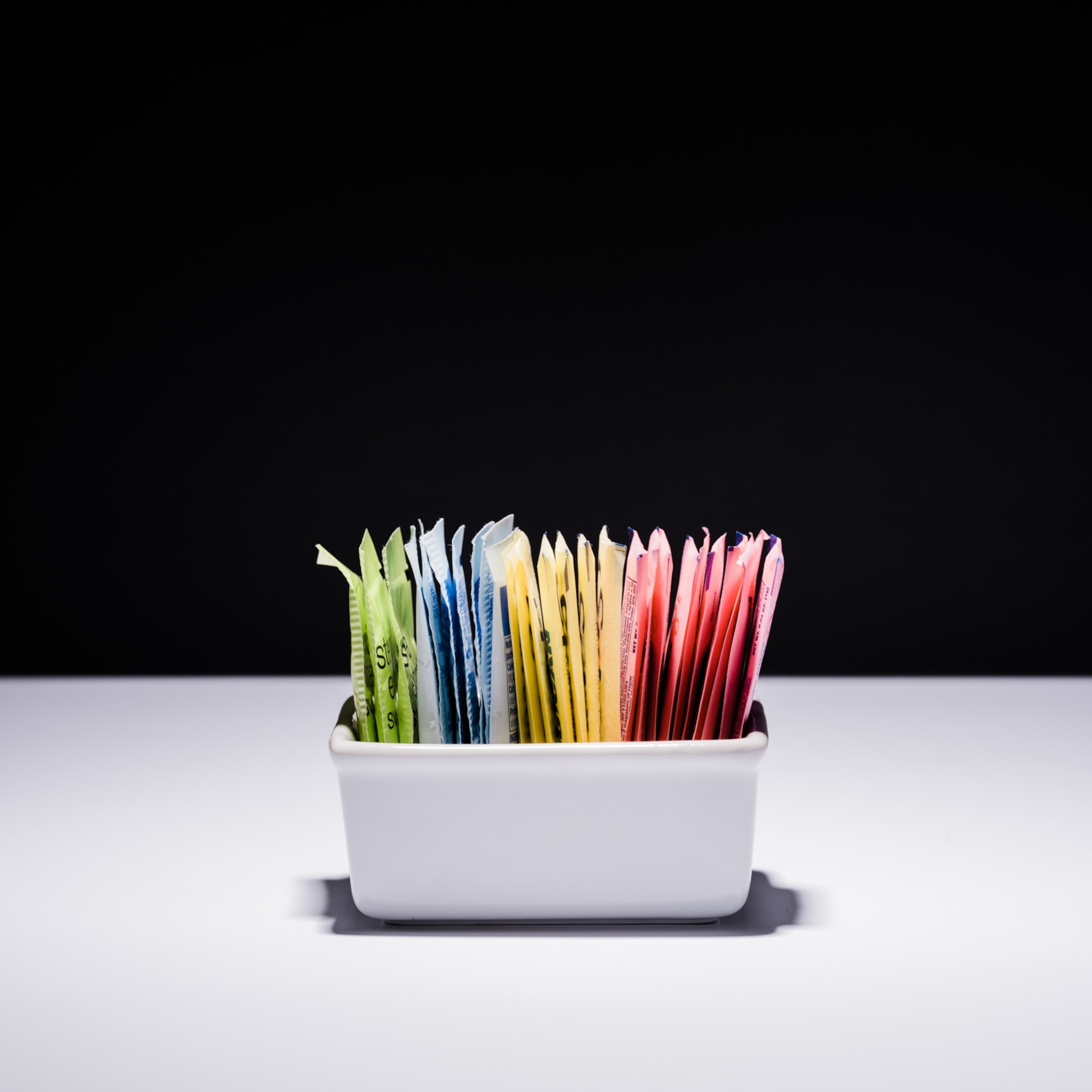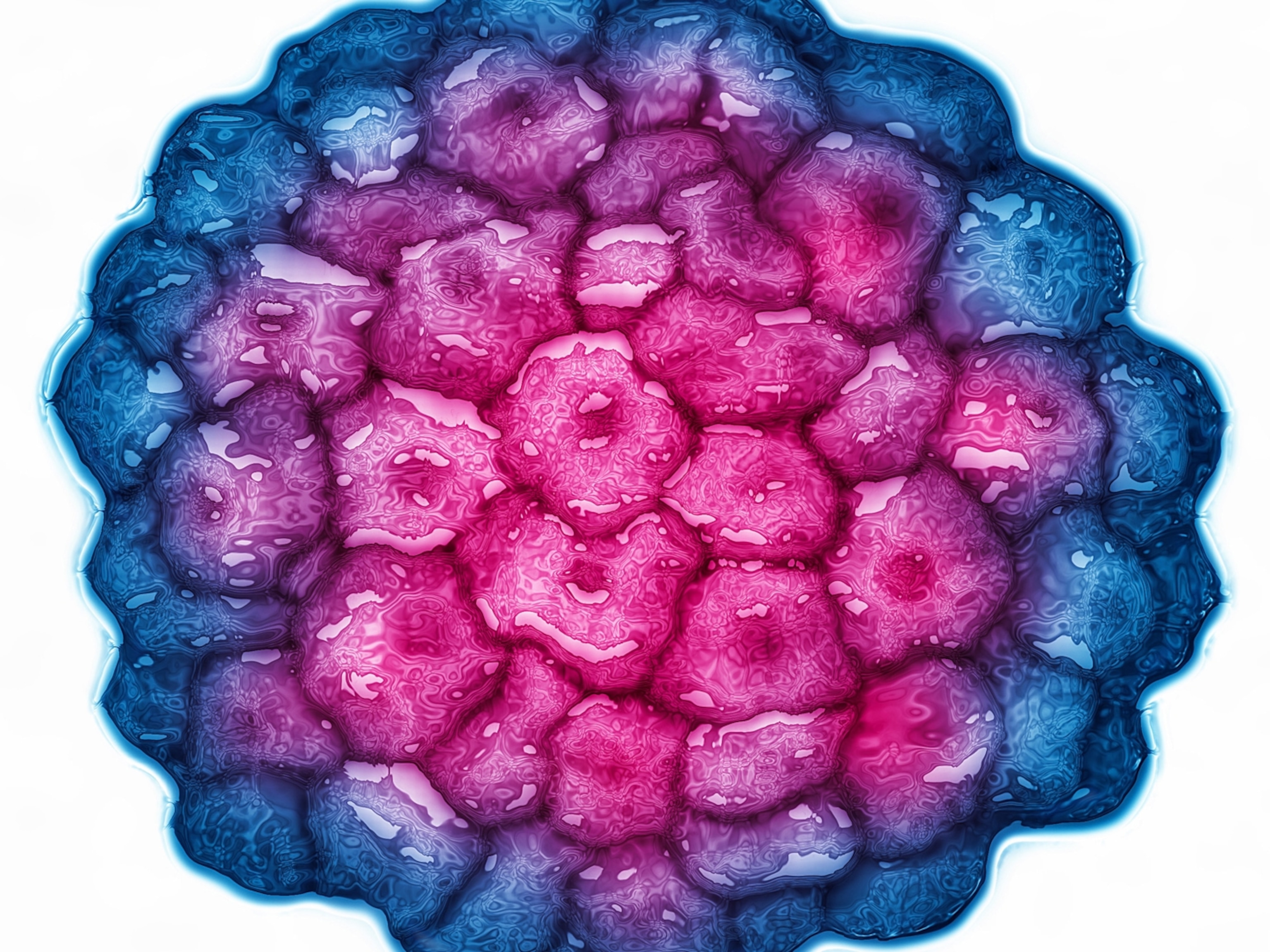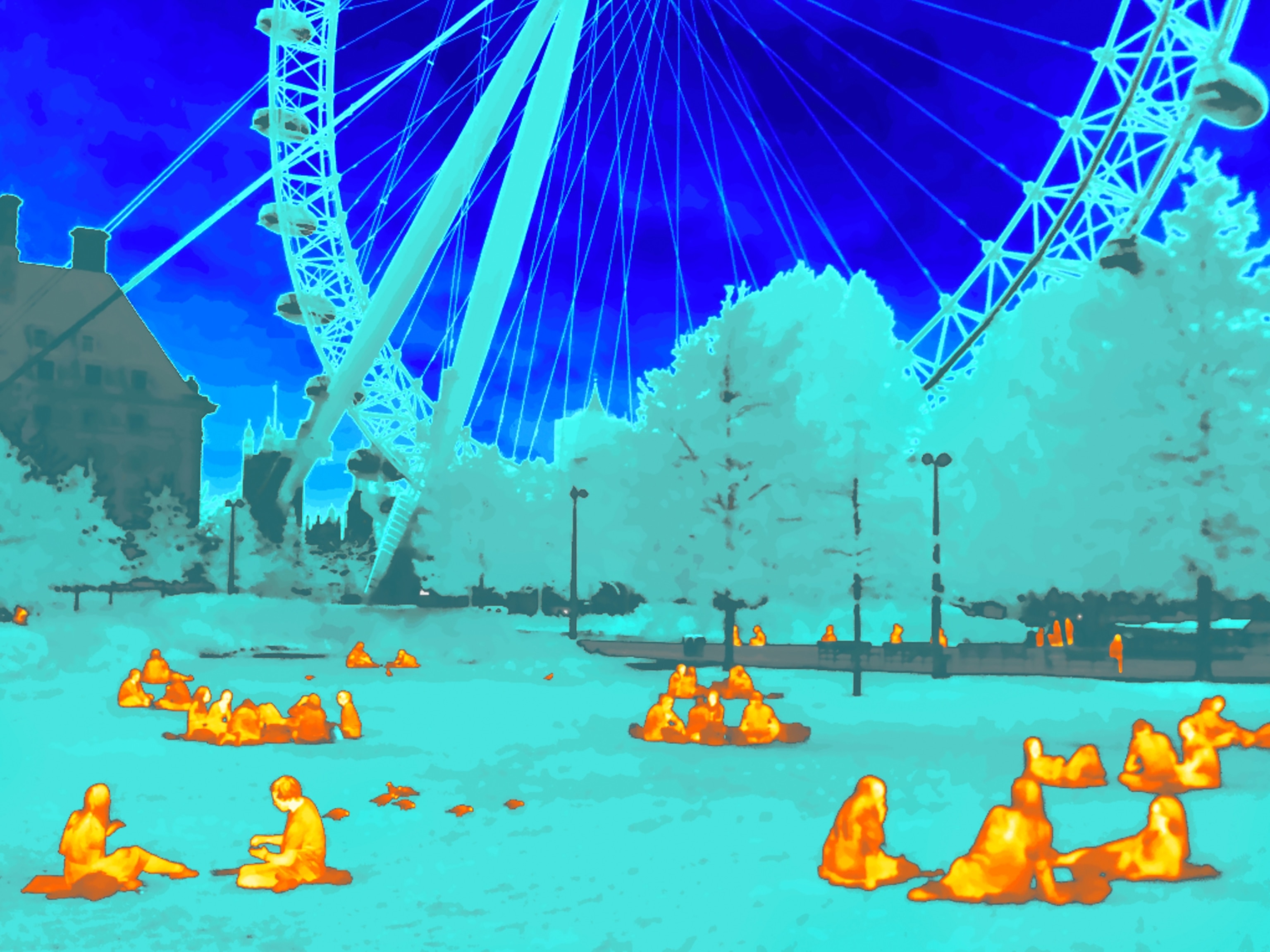
To end this pandemic, we must trust science
Researchers are struggling in fits and starts to understand the coronavirus, but that's how science works.
How these images were made: The photographer chose to capture our new routines with a thermal imaging camera to reflect how body temperature became an indicator of whether we might have the coronavirus. Temperatures are converted into a gradient of colors, ranging from cool blues to warm oranges.
If a theme runs through the books and articles I’ve written over the past 40 years, it’s a fascination with what scientists have learned about the human body. A long career spent explaining biomedical research has led me to a deep respect for the scientific process. Despite its occasional missteps and self-corrections, I believe it ultimately moves us toward a clearer understanding of the world and how to thrive in it.
So as scientists first scrambled to figure out the never-before-seen coronavirus, I was primed to follow their advice about how to keep safe, based on the hypothesis that the virus was transmitted mostly by droplets from coughs and sneezes lingering on surfaces. I dutifully wiped down countertops, refrained from touching my face, and washed my hands so emphatically that the little diamond in my wedding ring shone like never before.
And then, about two and a half weeks after my city, New York, shut down restaurants, Broadway plays, and the largest public school system in the country, scientists switched to a different message—that everyone should wear a mask. This was a startling about-face. The initial advice, confidently delivered, had been not to wear a mask, unless you were a frontline health-care worker. The revision was largely based on a new hypothesis, that the coronavirus spread mostly through the air. (See where coronavirus casese are growing and declining in the U.S.)
Which was it, then? Surface transmission or aerosols? Should we be more afraid of contaminated elevator buttons or people breathing near us? Did scientists even know?
The shift in advice about masks spooked me, I must admit. Not because of the new advice itself—I was more than happy to wear a mask if the experts said I should—but because of the ominous meta message I sensed beneath it: Scientists were figuring this thing out on the fly. The most earnest pronouncements from the world’s smartest experts suddenly sounded like little more than well-meant educated guesses.
As this devastating year draws to its raggedy close, it’s worth taking a moment to wonder what the long-term effect will be of watching scientists bob and weave on their way to a better understanding of the coronavirus and how to thwart the disease it causes, COVID-19—all out in public and all at breakneck speed. Even for a science geek like me, it has been unsettling to watch them debate, disagree, pivot, and reassess. I’ve been wishing instead that some lab-coated hero would just swoop in and make it go away. I was a baby in 1955 when Jonas Salk introduced his polio vaccine and vanquished a dread disease; ever after, my mother spoke his name with reverence.(1)
As scientists hustle to deliver us from a terrifying, seemingly intractable plague, there could be another happy ending—one that involves not just survival but also wisdom. If we learn any big takeaway from this doleful experience, I hope it’s not that our fellow human beings are myopic fools but that the scientific process can be trusted to get us through an existential crisis. (Follow National Geographic's comprehensive coronavirus coverage.)
Make no mistake: The challenge is huge and unprecedented. If a typical virus is a riddle wrapped in a mystery inside an enigma, the coronavirus known as SARS-CoV-2 is all that and more. It combines contagiousness and lethality in a ferocious mixture that Anthony Fauci, director of the U.S. National Institute of Allergy and Infectious Diseases, has called his “worst nightmare.” For one thing, when it appeared, no one on Earth had immunity. Second, it’s airborne and infects the upper respiratory tract, which means it’s readily spewed back into the air where it can drift from person to person. Third, and arguably worst, the virus is most contagious before it causes symptoms, meaning that carriers feel well enough to be up and about precisely when they’re most likely to infect us. (See what the coronavirus does to the body.)

The tricks this virus uses to foil the body’s counterattack are diabolically effective. Once it gets inside via the nose or mouth, the coronavirus eludes the first line of immune defense, slides easily into cells, churns out copies of itself by hijacking the cell’s machinery, and makes sure those copies work by using a proofreading mechanism that many other viruses don’t even have. Its effect is relentless: It can turn a person’s lung cells into useless material that looks like ground glass; blow open blood vessels or destroy them with microscopic clots; and gunk up the workings of a kidney, heart, or liver, rendering them too stiff to repair. It can defang the cells that attack invading viruses and then provoke a secondary immune reaction that goes badly haywire, paradoxically causing its own catastrophe.(2) And anyone who comes in close contact with a person already infected is likely—though no one is sure how likely—to get infected too.
Fauci’s worst nightmare? I could barely get to sleep.
As this pandemic threatens the entire world, the fight against it has been a very public one. The average citizen is getting insight into scientific theorizing that is normally confined to academic conferences and slow-moving journals. Much of the debate over these ideas is taking place on television, as well as on Twitter, on Facebook, and in the backyard gatherings of lawn chair epidemiologists. I find myself wondering if anyone engaged in this chatter understands how science actually works.
One way it doesn’t work is through the lone Jonas Salk–like hero that captivated me as a child. Science is a collaboration, with many heroes. We’re seeing that now, as thousands of researchers have reoriented their labs, no matter how far afield from virology or infectious disease, to attack this hydra-headed problem collectively. There has never been anything like it, with scientists collaborating across borders at full throttle—even as some of their political leaders snipe at one another.

Watching this ramped-up scientific effort has felt double-edged: encouraging to see but so hard to follow that it also added to my free-floating anxiety. So I did what I’ve done my whole adult life—called up some scientists to see what they think. This is a wonderful benefit to being a journalist, being allowed to ask dumb questions of smart people. Usually it helps me clarify my own thinking. This time … not so much.
Science on the frontier always exposes how little is known, even by the putative experts, so these phone calls made it clear to me how far we have to go. Still, it was nice to hear that a lot of scientists were looking for answers.
“It’s been amazing to see how people are using their talents and gifts to address this,” Gregg Gonsalves, co-director of the Global Health Justice Partnership at Yale University, told me. “People all want to do something,” even if their training is in law, geography, anthropology, fine arts, or similarly far-flung fields.
There has never been anything like it, with scientists collaborating across borders at full throttle—even as political leaders snipe at one another.
All that research focus has led to a remarkable amount of information in a remarkably short time. Within weeks of the first known animal-to-human transmission, scientists had sequenced the virus’s full genome. By summertime, more than 270 potential COVID-19 drugs were in active clinical trials in the United States. As for the quest for the holy grail, a vaccine, an international phalanx of researchers from the U.S., China, Great Britain, India, Germany, Spain, Canada, Thailand, and elsewhere had identified more than 165 candidates by early August. Progress was so rapid that even a hyper-realist like Fauci—who tends to emphasize how important it is to conduct large-scale clinical trials before introducing new drugs—has said he is “cautiously optimistic” that a vaccine could be available early next year. If he’s right—oh please, oh please, let him be right—that would be three years faster than the fastest vaccine development in history.(3)
Sometimes science simply cannot be rushed, though. “There is some sort of serendipity to the scientific enterprise,” Gonsalves told me. “The speed and scale of what is happening now could be just a prelude to the chance discoveries we’re going to have to make over a longer period.” Bottom line: “You can’t scream a cure out of a test tube.”
Next I called Howard Markel, director of the Center for the History of Medicine at the University of Michigan, to talk about another source of my anxiety: that the coronavirus seemed to shape-shift in a uniquely terrifying way. It felt like every day I opened the newspaper to read that a new organ system was subject to its ravages or a new age group was vulnerable. But Markel, who has made a career studying the history of epidemics, told me that was to be expected: The apparent explosion of new and varied symptoms happens with any highly contagious virus when it bursts on the scene.
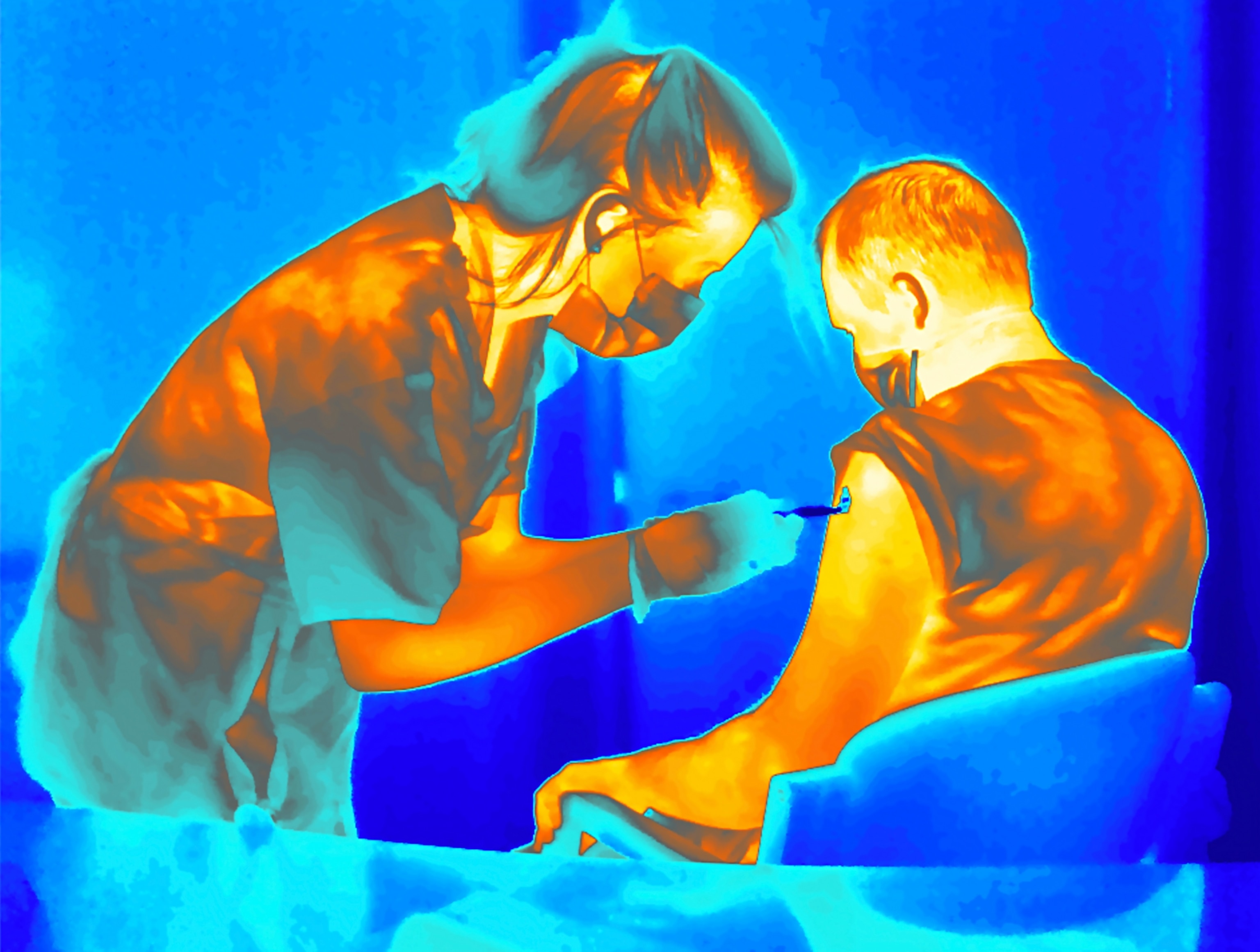
“The more clinical material you have, the more patients, the more chances you have to see this protean nature,” he said. It’s what happened in the early days of the AIDS pandemic in the 1980s, when Markel was just starting his career. At the dawn of any new disease, strange manifestations keep showing up and surprising doctors. Even if the odds of a rare symptom are, say, just one in a thousand, doctors are going to see a lot of it, Markel said, because a thousand patients can accumulate practically overnight with a crazily contagious new illness like this one.
So the U-turns and revised pronouncements about COVID-19 aren’t signs that scientists are flummoxed; they’re signs that scientists are generating a torrent of new information and are trying to make sense of it as they go.
Last I called an old friend, Stephen Morse, a professor of epidemiology at the Columbia University Mailman School of Public Health. Morse was the subject of a book I wrote nearly 30 years ago about emerging viruses, in which he basically predicted our current catastrophe.(4) Today he feels a bit put off by the frenzy.
“This is not the way I would like to see science being done—it’s happening so quickly,” Morse told me. He strained to look for a bright side. “A lot of knowledge is becoming available,” he ventured. And if some of that supposed knowledge ends up being wrong, he said, seeming to strain even harder, couldn’t that be construed as a good thing? “Science is a self-corrective process. Maybe even the effort to correct the errors will lead to improved knowledge.” Maybe. But I didn’t feel better when we hung up.
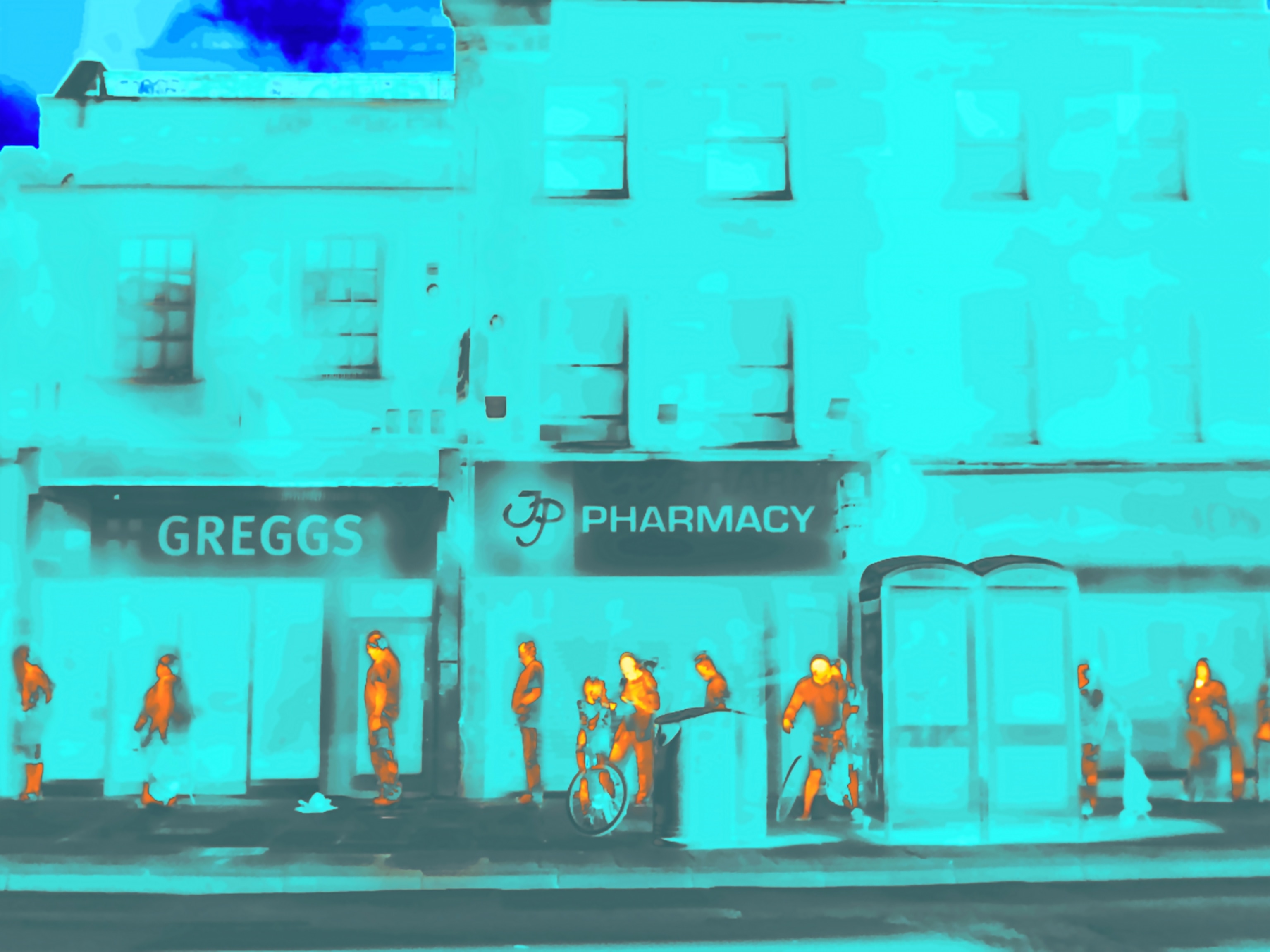
Still troubling me were a couple of things. First, the politicization of the process could upend everything. Even if science closes in on a more accurate view of COVID-19 and how to treat and eventually prevent it, that might not be how the story is spun. Enough conflicting interests and alliances exist for the truth to be turned on its head without too much effort, making it seem as if scientists who amended their views based on new evidence were pretty much wrong from the start.(5)
Second, the science itself might suffer. If researchers take shortcuts for the sake of expediency or jump too far ahead of their data to offer advice, they might unwittingly tarnish the very process they depend on. Indeed, not long after I spoke to Morse, I read a report from a team of epidemiologists and biostatisticians from the Johns Hopkins Bloomberg School of Public Health that suggested a lot of the early research was too perfunctory to be of much use.
The scholars analyzed the first 201 COVID-19 clinical trials, which had been conducted in China, the U.S., and other countries. It seemed there had been a lot of corner cutting. One-third of the trials had no clear definition of treatment success; nearly one-half were so small (100 or fewer patients) they weren’t really informative; and two-thirds lacked the gold standard safeguard known as “blinding,” which keeps investigators from knowing which subjects are getting the treatment under study.
Maybe the pandemic will persuade even the skeptics how crucial scientific discovery is to human flourishing.
These less-than-ideal clinical trials were reported anyway, partly because leading scientific journals, such as the New England Journal of Medicine and those published by PLOS, had pledged to accelerate the peer review process, rushing coronavirus articles into print in half the usual time. Another avenue of publication involves preprint servers, which post articles online before they’re peer-reviewed. These servers, created to promote transparency in scientific research, predate the pandemic, but they exploded in popularity as coronavirus studies were churned out. Journalists, their readers ravenous for any updates, wrote articles about studies on these preprint servers no matter how small, no matter how tentative.(6)
As new findings, even weak or conditional ones, are publicized that contradict earlier findings, those of us trying to follow along can end up frustrated and confused. But while frustration and confusion among the science-minded might be unfortunate, it’s not deadly. What really worries me is that those skeptical of science might see the apparent flip-flops as reason to turn against evidence-based advice altogether.
The anti-science sentiment is out there, in the U.S. and elsewhere, and it’s pernicious, having led to doubt about expert consensus on climate change, gun control, vaccine safety, and other hot-button issues. We’re also seeing the emergence of COVID truthers, who insist the pandemic is either a conspiracy or a hoax. (Or maybe both? It’s hard to keep track.) They venomously slam public health officials, some of whom have quit after one too many death threats. It has been astonishing to watch videos of people screaming at store owners or city council members for requiring them to wear masks. (New algorithms can detect whether people are complying with public health guidance.)
This is not just an American phenomenon. With coronavirus misinformation, disinformation, and conspiracy theories circulating around the globe, the World Health Organization has declared that we are facing two public health outbreaks at once: the pandemic itself and an “infodemic” of dangerously misguided ideas about it.
But you don’t need to be an unhinged COVID truther to be resistant to learning whatever lessons this pandemic can teach us; you just need to be an ordinary, shortsighted, fallible human.

“Every epidemic I’ve ever studied always ends with global amnesia,” Markel said. “We go back to our merry lives.” The “glaring problems” that contributed to the outbreak—urbanization, habitat destruction, international travel, climate change, war refugees—simply persist, he said, as people lose interest in demanding that more time, money, and brainpower be devoted to science. “Politicians move on to the next show, while policymakers cry out in the wilderness, ‘We still need this!’ ”
Already the 21st century has been what Markel calls the century of epidemics: SARS in 2003, H1N1 influenza (swine flu) in 2009, MERS in 2012, Ebola in 2014 to 2016, and now COVID-19 in 2019, 2020, and who knows how many years beyond. Five epidemics in 20 years, each one a little worse than the one before—and this one many times worse than the other four put together.
Maybe, in a weird way, watching scientists try to build a plane while they’re flying it—as some have described coronavirus research—will be good for our overall understanding of the scientific process. Maybe the pandemic will persuade even the skeptics how crucial scientific discovery is to human flourishing.
That’s the hope of Lin Andrews, director of teacher support at the National Center for Science Education. “People innately trust scientists overall, but when it’s a polarized topic, things can go wonky,” said Andrews, a former high school biology teacher. She and 10 colleagues, seeing the pandemic as a teachable moment, have devised a five-part lesson plan, good for classroom or home use depending on whether particular school districts are open. It focuses on epidemiology as a way to educate high school students—and, by extension, their parents—about what the scientific process entails.
The course shows how scientists construct their theories, Andrews said, by emphasizing “all these stumbles that were made along the way.” It includes milestones in epidemiology, such as when British scientist John Snow traced the London cholera outbreak of 1854 to contaminated drinking water. No one believed Snow—the prevailing theory was that cholera was spread through the air in a contagious “miasma”—until he had the handle removed from the water pump on Broad Street, shutting off the contaminated water supply and stopping the outbreak.(7)
Snow’s realization came years before the confirmation of germ theory, which explains the existence of pathogens. He didn’t understand how cholera was transmitted in the water, simply that patterns of disease indicated it was. Learning about the step-by-step progression of historical discoveries will, Andrews hopes, put in context the fits and starts of contemporary scientists’ attempts to understand COVID-19.
Maybe our unfiltered view will turn out to be a good thing. After all, the best way to build trust in science is by showing all of its hypothesis testing and hypothesis tweaking—maddening to watch while we’re anxiously awaiting answers to a global plague, but in the end the only way toward results that will allow us to move on with our lives.
Surveys show the general public is less dismayed by watching scientists in action than I had feared. Since 2015, the Pew Research Center has tracked what Americans think about science, and it has steadily become more positive, including in a poll conducted in April and May 2020 as the coronavirus was cresting and many of those surveyed were under lockdown.
In January 2019, the last survey before the pandemic, respondents were already inclined to trust scientists, with 86 percent saying they had a “great deal” or a “fair amount” of confidence that scientists had the public interest at heart. That level of trust inched up to 87 percent amid the pandemic.
But when I called Cary Funk, the director of science and society research at Pew, to talk about these encouraging results, she told me not to get ahead of myself, that the story is a bit more complicated. According to Funk, the surveys show a deep partisan divide in how much scientists are trusted. Republicans and Republican-leaning independents still seem reluctant to embrace science wholeheartedly. They are about half as likely as Democrats to express a “great deal” of trust in scientists—a proportion that has stayed stubbornly low at 27 percent.(8)
Pew’s surveys also reflect a deep racial divide in attitudes toward science. Black adults, according to the poll conducted earlier this year, are less likely than the general population to trust medical scientists. They are also less likely to have confidence in new COVID-19 treatments or vaccines; just 54 percent of Black respondents would “definitely” or “probably” get a COVID-19 vaccine, compared with 74 percent of whites and Hispanics. This distrust, exacerbated by the substandard care many Black patients get in doctor’s offices and emergency rooms, is especially troubling in the context of COVID-19, which kills Blacks at more than twice the rate at which it kills whites.
The racial and political divides in how science is viewed are especially insidious now, when skeptics could undermine whatever progress scientists make in the coronavirus fight. In the worst-case scenario, if enough doubters ignore control measures and vaccines, that could strip science of its ability to protect us altogether.
I'd like to believe Andrews is right about this being a teachable moment—maybe not so much for those of us already fixed in our views, but for those whose childhood is being shaped by the coronavirus. These children—whom some are calling Generation C—might grow up with less patience for the polarization fogging our responses today. Let’s say they spend their formative years watching the scientific process up close. And let’s say that in the end, scientists actually do save the day.
Now it’s the year 2040, and Gen C is all grown up. Suddenly a new pandemic emerges. Based on what they learned by living through COVID-19 at an impressionable age, these young adults recognize the urgency of the new outbreak, quickly dismissing any claims that it’s a hoax. They put on masks, maintain social distance, get vaccinated as soon as a vaccine is developed (and it’s developed quickly, because scientists have also learned a thing or two in the interim, as have politicians). They follow experts’ recommendations because they know it’s the best way to protect not only themselves but also their neighbors from a plague similar to the one they grew up with that killed hundreds of thousands of people around the world.
Gen C gets through the new pandemic with relatively few deaths or economic disruptions because they learned some crucial lessons when they were children: that public health advice is based on the best available data, that such advice can change as new evidence accumulates, that science is an iterative process that cannot be fast-tracked.
Maybe by then there also will be more workers in the professions that got us through the coronavirus catastrophe: more doctors, nurses, paramedics; more specialists in infectious disease, epidemiology, virology, and microbiology, each of them having chosen a career that as kids they had watched in its finest hour. It has happened before. Some of the scientists now engaged in the struggle against the coronavirus, such as Gonsalves and Markel, ended up where they did after working to help untangle AIDS, an earlier viral mystery that killed us in ways never seen before.
So the question is whether Gen C will respond with something other than “global amnesia” when the next plague arrives, as it almost surely will. This is what I yearn for, not just for the sake of my own bruised confidence but also for the sake of my two beloved granddaughters, who would have to live the reality I’m most fretting about.
Much depends on what happens in the coming months.
Imagine, for the sake of argument, that the epidemiological curves I’ve obsessed over all year ultimately play out in our favor, and we can return to some semblance of normal. Imagine that effective treatments are found that make COVID-19 short-term and curable for just about anyone. Imagine that a vaccine is developed soon and that a significant portion of the world population gets it. If all that happens, why wouldn’t we emerge from this with a greater appreciation of the scientific enterprise in all its messy brilliance?
I try to hold on to that hope, despite the catcalls of politicians and “personal choice” zealots who second-guess everything the scientists do. I try to tell myself that sometimes our better angels prevail. And that there’s an army’s worth of better angels—scientists, educators, doctors, nurses, public health advocates—who, since that eerie image of the spiky coronavirus started haunting our collective dreams, have been working tirelessly toward a happy ending.
That’s the ending I’m trying to believe in, where we emerge from this with a renewed appreciation of science as humanity’s best chance of salvation from suffering and untimely death.

